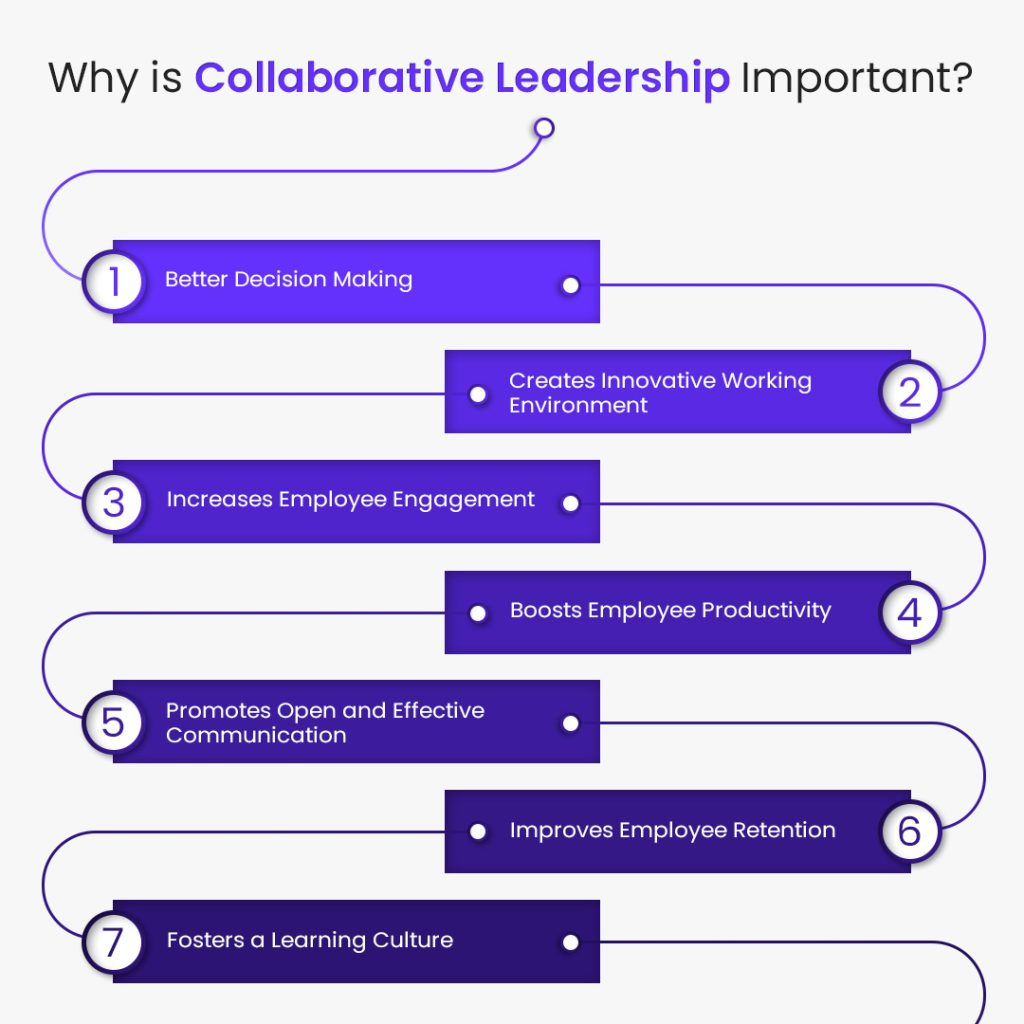
In this ever-changing business world, leaders who strive to be collaborative are known to cultivate a positive work culture.
With collaborative working culture, employees cooperate with their team leaders to accomplish a shared goal. This style of leadership leverages the strengths of different working teams.
Do you want to create a working culture where every employee in the organisation takes responsibility for the outcome of their tasks?
Embrace a collaborative leadership approach that involves actively seeking input and contributions from team members, valuing their diverse perspectives, and creating an inclusive environment.
The team-based way of operating brings together each and every member of the organisation and motivates them to provide their valuable inputs and contribute to business success.
Why is Collaborative Leadership Important?
Collaborative leaders value team members hailing from varied socio-economic backgrounds with equal respect. They enable open communications and focus on setting up processes for smoother workflows.
With the following benefits, they foster a collective approach to problem-solving:
1. Better Decision Making
Decisions as a team effort are more thoughtful and reflective of diverse viewpoints! With a sense of community and attachment, collaborative leadership is one of the best practices for building stronger teams and empowering them to arrive at better decisions.
2. Creates Innovative Working Environment
Collaborative leadership fosters a creative and innovative working culture. When management involves employees of every level in projects, they engage with the goals of the organisation and contribute their unique insights and ideas, resulting in the development of the most effective and novel solutions.

3. Increases Employee Engagement
If one of the significant challenges you face as a manager is employee disengagement, a collaborative leadership approach is your best solution!
As a collaborative manager, when you work alongside the employees you oversee, you are likely to have higher engagement levels within your team as compared to authoritarian managers. When you work as a part of the team and not above them, employees start trusting you more with their increased engagement towards organisational goals.
4. Boosts Employee Productivity
When multiple teams come together to tackle a complex project, they address the challenges involved in the project with a broad range of skills, strengths and expertise.
Thus, diverse talents present in an organisation are best utilised through a culture of collaborative efforts.
5. Promotes Open and Effective Communication
Collaborative leaders encourage clear and open communication amongst different teams. With their reliance on effective communication, misunderstandings are hard to arise, thereby, fostering a positive team culture.
6. Improves Employee Retention
In the fast-paced business world, employee retention is a task! When employees feel valued and their contributions are appreciated, they are more likely to stay part of your organisation. A collaborative and supportive team lowers turnover rates and retains the best talents longer.
7. Fosters a Learning Culture
As a part of collaborative leadership, managers create an environment that encourages continuous learning. By sharing knowledgeable insights, they often contribute to the professional development of every employee part of their team.
Final Words
In the rapidly changing business landscape where innovation, adaptability, and effective communication are essential for business success, collaborative leadership recognises the value of collaborative efforts of employees in achieving common goals. Collaborative managers enable different team members to come together, share their perspectives and create a culture of continuous collaboration. Thus, collaborative leadership is a key force driving the organisational world.
Follow me on LinkedIn
Frequently Asked Questions
What is Collaborative Leadership?
Collaborative leadership is one of the leadership styles that leverages the strengths, perspectives and experiences of different team members to achieve business goals. This leadership approach recognises that no single team member is capable of handling all the business challenges and thus, the combined efforts of diverse and talented teams result in better outcomes.
Who is a Collaborative Leader and what are some of the Collaborative Leadership Traits?
Collaborative leadership involves a set of specific traits given below:
1. Inclusiveness:
A collaborative leader seeks input from different team members and values their diverse perspectives and experiences. By working effectively with teams, he/she creates an inclusive environment where employees feel heard and respected.
2. Open Communication:
A collaborative leader also encourages transparent and honest communication. By encouraging open communication, he/she ensures that information flows freely within the teams.
3. Empathy:
A collaborative leader must empathise with the needs and concerns of his/her team members. This trait helps in building stronger work relationships and creates a supportive team culture.
4. Flexibility:
A collaborative leader recognises the dynamic nature of the business environment and is open to change. By encouraging flexibility amongst teams, employees can quickly respond to challenges and grab business opportunities.
5. Shared Decision-Making:
A collaborative leader knows how to involve different team members in the decision-making process. The collective intelligence of the team with the leader’s guidance drives business growth.
Thus, a collaborative leader promotes open communication, values diverse perspectives of employees, and fosters a cooperative and supportive work culture. For example, Indra Nooyi, the former CEO of PepsiCo and Satya Nadella, CEO of Microsoft are well-praised for their collaborative approach to encouraging teamwork and building a more inclusive and collaborative corporate culture.



